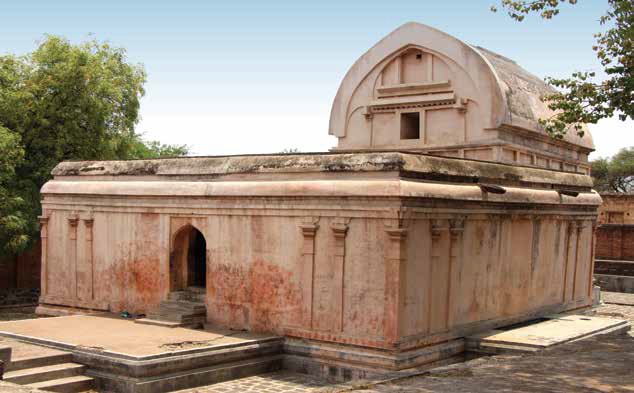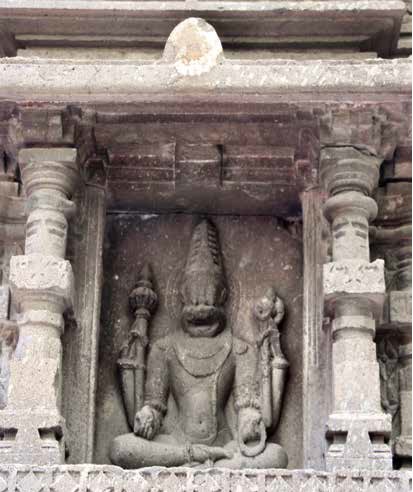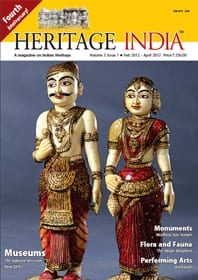Revisiting the Golden Era
Marathwada has a rich heritage and its politics, economics and culture has impacted Maharashtra to a huge extent. The caves of Ajanta, Ellora and Pitalkhora and the places of pilgrimagethat attract thousands of people each year are just a few examples. Marathwada, in fact, has some of the most beautiful temples of the state, spread across the districts of Aurangabad, Parbhani, Nanded, Beed, Osmanabad, Latur, Hingoli and Jalna. Most of these ancient temples can be traced back to the dynasties that ruled over Marathwada, beginning from the Satavahanas. The Vakatakas, Chalukyas and the Rashtrakutas followed. It was during the ‘golden’ period of the later Chalukyas that the activity of building temples gained momentum, taken further by the Devgiri Yadavas. These temples are locally known as the ‘Hemadpanti’, named after celebrated Sanskrit author Hemadpant who was the prime minister of Yadava ruler Raja Ramchandra. Here are the descriptions of some of the most famous temples of the region.
Trivikram Mandir, Ter: Known as the brick temple of Maharashtra, it has been traced to the earlier Buddhist Chaityagriha or prayer hall. It is similar to the rock-cut ratha temple of Nakul-Sahadev at Mahabalipuram as well as the Chezarla temple. While there are controversies about its date of construction, according to new findings, this temple belongs to between 3rd and 4th century. The temple was built out of mud bricks made of fine alluvium soil mixed with lime plaster. Surprisingly, it wasn’t damaged at all during the massive earthquake of 1993.
Uttareshwar Mandir, Ter: Dedicated to Lord Shiva, it is located in the middle part of Ter village of Osmanabad. The temple was built out of bricks and wood. There is a shivalinga in the sanctum, behind which are the icons of Surya and Vishnu. The exterior of the temple is decorated and stylistic. The bricks used for its construction are ornamented with floral designs. A unique characteristic of the temple is its doorjamb which, according to a historian, represents the Chalukyan style of architecture and design. This doorjamb has now been preserved at the Lamture Museum at Ter. This temple belongs to 5th-6th century CE.
Kaleshwar Mandir, Ter: This temple is located on the bank of river Terna at Ter. Built out of bricks, it has a construction style similar to the Uttareshwar Mandir. An indication that it was dedicated to Vishnu is the icon of a Garuda. There is a shivalinga with pillars outside the temple as well as an interesting sculpture of a lion killing an elephant. The temple is said to belong to 7th century CE.
Later Chalukyan Temples:
Shri Mahalaxmi Mandir, Jagji: Jagji is famous for this temple, located 32 km from Osmanabad. The temple is dedicated to Goddess Durga and there are a series of smaller shrines on the main shikhara. The temple has a step-well in front, locally known as Lakshmitirth. It has 24 niches and according to some sources, 24 icons of Vishnu were housed in the niches. A characteristic feature of this step-well are the animal figurines.
Shiv Mandir, Mankeshwar: This is located at Mankeshwar in tehsil Bhum of district Osmanabad on the bank of river Vishwakarma. The temple represents the finest specimen of Chalukyan architecture. It faces east and has a star-shaped plan that includes the pradakshinapatha. There are 347 icons on its exterior walls. The sabhamandapa is a square hall and its ceiling is supported by four beautifully carved pillars in the navrang style with the design of a lotus and an icon of Natraj Shiva. The doorframe and the pillars are the characteristic features of this temple. The doorjamb of the shrine is huge and referred to as Jyethadwara of Hastini variety, rarely found in Maharashtra.
Shiv Mandir, Umarga: This is located at Umarga in Osmanabad district and is one of the temples of the Chalukya period. Basav Kalyani, the capital of the later Chalukyas, is 30 km from here. In a state of good preservation, the interior of the temple is particularly interesting for its decorative style. The temple stands on a very high plinth and its mukhamandapa is an open–pillared porch. On both sides of the entrance of the mukhamandapa is a parapet with friezes of elephants carved on the walls. The mandapa is screened off from the mukhamandapa by two pillars.
Nilkantheshwar Mandir, Nilanga: Nilanga is a taluka headquarter in Latur district. This temple is located to the east of the village. The temple faces the east and its ground plan is star-shaped. This indicates a developed stage in temple architecture. The temple’s mandapa has 16 pillars, all finely decorated with thick shafts. There are four niches in the mandapa which too are elaborately carved. The arrangement of its ceiling is based on a geometrical design and the doorframe has several animal motifs, flying gandharvas, yakshas, pilasters and floral designs. The icon carved on the lintel is of Gajalakshmi. The presence of Saptamatrika (seven mother goddesses) and Gajalakshmi clearly suggest Chalukyan influence on the sculptures. There are 103 sculptures in the temple, all delicately carved and with decorative earrings and elaborate headgears.
Vitthal Mandir, Pangaon: Pangaon village is situated in the Renapur taluka of Latur district at a distance of 30 km from Parali Vaijnath and 33 km from Latur. The temple of Vitthal is located to the west of the village and stands on a raised platform. The temple is rectangular in plan and has projecting chambers on all the sides. On the parapet wall of the mukhamandapa are carved a number of horizontal friezes of elephant, floral motifs, and turreted pilasters with small images intervening in between them. The mandapa has ornamental doorframes with 43 pillars, all of them identical. These are arranged in two rows around the rangshila or performance area and such an arrangement forms a rectangular corridor. The pillars of the ardhamandapa have bracket sculptures of sursundaries. The exterior walls of the temple have 41 sculptures of dancers and musicians and the base has an elephant band (gajathara), followed by a decorative frieze with a floral motif.
Khadakeshwara Mandir, Jamkhed: Jamkhed village is situated in Ambad taluka of the Jalana district, at a distance of 75 km from Aurangabad. There are three temples in the village of which the Khadkeshwara Mandir is the oldest. The temple faces west, dedicated to Shiva. Now in a dilapidated condition, it stands on the ground level and is worth a visit for its 20 pillars, eight of which are ornamented. These pillars have capitals with dwarf motifs carved on them. The others are less ornamented and slender in form. The lintel has image of Ganesha. The exterior of the temple is angular in form and seems to suggest the shape of a star.
Kedareshwara Mandir, Dharmapuri: Dharmapuri is a small village located at a distance of about 30 km from Ambajogai in district Beed. The ground plan of the temple and the pillars are similar to Siddheshwara Mandir and it stands on a high plinth, facing east. The central portion of the ceiling is richly ornamented. The exterior walls of the mandapa have been reconstructed in stone and mud while its side porches are enclosed by a parapet wall which has sculptures in the horizontal frieze style. The architectural features and sculptures clearly indicate a Chalukyan influence.
Shiv Mandir, Anwa: Anwa is a small village in the Sillod taluka of Aurangabad district. The temple is dedicated to Shiva and faces east with its architectural motifs and carvings indicate Chalukyan influence. The temple stands on a raised platform with a flight of steps. It consists of an open mandapa that has decorative projections on three sides, giving it the form of a star. The central ceiling is the finest example of architectural ornamentation with a dome-like shape having an inverted half-blown flower along with eight small floral designs. In the centre of the mandapa is a raised platform with a huge Nandi. The lintel has a seated figure of Ganesha.
Vadeshwar Mandir, Ambhaivadgaon: Ambhaivadgaon is located near the Ajanta hills, 25 km from Sillod tehsil in Aurangabad district. This is one of the beautiful Chalukyan temples with a star-shaped tridala structure comprising three shrines. The main sanctum was d e d i c a t e d to Shiva (Vadeshwar) while the southern shrine was dedicated to Vishnu and the northern to probably a matrika because the uttaranga has sculptures of saptamatrikas that reveal dedication to a goddess. The sculptures of Brahmi, Saraswati and Vaishnavi are enshrined in the niches of the antarala while the exterior walls of the temple are adorned with beautiful sculptures of ashtadikpala, forms of Shiva, and sursundaris.
Kankaleshwara Mandir, Beed: The Kankaleshwara temple is located in the Beed city on the banks of river Bindusura at a distance of 125 km to the south of Aurangabad. Dedicated to Shiva, it faces west and consists of a mukhamandapa, mandapa, vestibules and three shrines. The ground plan is similar to those of Nilkantheshwar Mandir at Nilanga and the Shiva Mandir of Umarga. The temple stands in a big water tank. There are 54 pillars and six pilasters in the temple. The mandapa is an open-pillared hall, octagonal in shape with 18 pillars on the top of which rests the ceiling. The pillar types, ceiling pattern, doorframes and the exterior sculptures show that it was built in the 11th -12th century under Chalukyan patronage.
Text and Photographs © Maya J. Patil Source: Maharashtra Unlimited Vol 5 Issue 2








